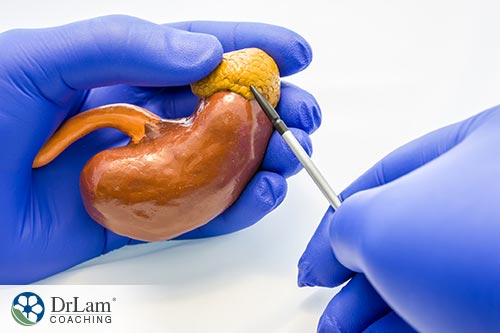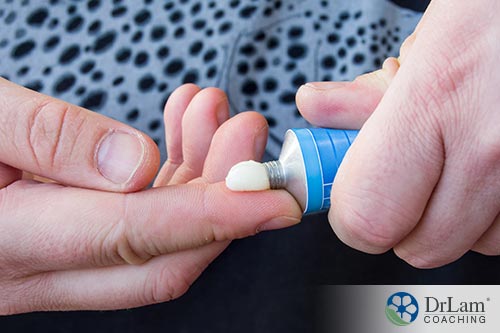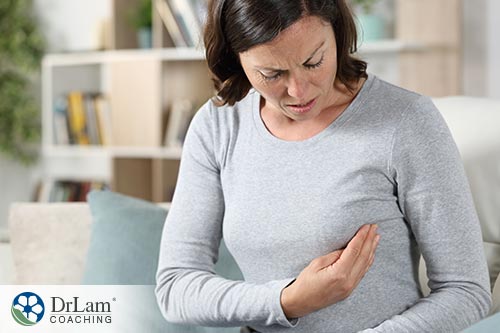 Adrenal fatigue and estrogen dominance go hand in hand. They are both a result of the dysregulation of the hormone circuit. The NEM is your body’s global response to stress, and it’s composed of six circuits: The Hormone, the Bioenergetics, the Cardionomic, the Neuroaffect, the Inflammation, and the Detoxification circuits.
Adrenal fatigue and estrogen dominance go hand in hand. They are both a result of the dysregulation of the hormone circuit. The NEM is your body’s global response to stress, and it’s composed of six circuits: The Hormone, the Bioenergetics, the Cardionomic, the Neuroaffect, the Inflammation, and the Detoxification circuits.
» Read our complete long-read article on Estrogen Dominance
» Adrenal Fatigue FAQs
» Take our 3-minute test to see if you may have Adrenal Fatigue
The Hormone circuit is composed of the adrenal glands, the thyroid, and the reproductive organs. In women, those would be the ovaries, where estrogen is produced. If any of the three components is not working optimally, it affects the other two. And if the Hormone circuit dysregulates, it affects the rest of the NEM as well.
With adrenal fatigue, the adrenals are the component most affected. And chronic stress is the underlying cause.
Although your body is made to handle acute stress once in a while, it is not built to handle chronic stress. And these days, most people are chronically stressed. Stressors can be physical or psychological, and for you, it could be both. Physical stressors include things like an unhealthy diet, exposure to toxins, smoking, overconsumption of alcohol, a chronic illness, a sedentary lifestyle, recurring infections, and taking certain medications.
When your adrenals have to keep increasing their cortisol production, at some point they dysregulate. This leads to Adrenal Fatigue Syndrome (AFS), with symptoms like fatigue, weight gain, anxiety, mild depression, brain fog, PMS, infertility, low libido, lowered immunity, hypoglycemia, salt and sugar cravings, hair loss, dry skin, and heart palpitations.
As you can see, some of the symptoms of AFS have to do with the reproductive system. That’s mainly due to how the adrenal glands, thyroid, and ovaries are connected. Together they form the ovarian adrenal thyroid (OAT) axis. When one part of this axis is out of balance, it affects the rest.
The usual case is that when the adrenals are not working well, the balance between estrogen and progesterone is disrupted. These two hormones keep each other in check, and when one is relatively higher than the other, we say that it is dominant. With estrogen dominance, your estrogen levels are relatively higher than your progesterone levels.
Symptoms of estrogen dominance include:
Sadly, estrogen dominance is very common – almost 50% of women over the age of 35 are affected. Men suffer from estrogen dominance as well, with symptoms like sexual dysfunction, breast enlargement, and infertility. The difference with men is that estrogen is relatively dominant over testosterone rather than progesterone.
Estrogen and progesterone should work in sync to keep each other in check. For example, estrogen proliferates the endometrium while progesterone restricts that growth. Estrogen creates fluid retention while progesterone is a natural diuretic. Estrogen can cause cysts and tumors in the breasts while progesterone protects against cancer. Your body is always trying to reach or maintain homeostasis in order to be healthy. But as you age, your estrogen and progesterone levels decrease, but they are decreasing at different rates.
Usually, progesterone production declines at a faster rate than estrogen. This decline is especially pronounced during perimenopause and menopause. Between ages 35 and 50, your progesterone production decreases by around 75%, while estrogen production decreases by around 35%. When you reach menopause, your progesterone is very low compared to estrogen.
That decline, combined with the decades-long exposure to substances and lifestyle choices that increase estrogen levels, is what results in the relative dominance of estrogen over progesterone. This means that you now don’t have enough progesterone to counteract the effects of estrogen. That’s why estrogen dominance can lead to other health conditions such as fibrocystic breast disease, endometriosis, PCOS, PMS, breast cancer, uterine fibroids, autoimmunity, and infertility.
 As we already mentioned, the OAT axis links the three main components of the Hormone circuit. Depending on which component is most affected, you’ll see different symptoms becoming more prominent. For example, if your adrenal glands are the primary organ involved, your main symptoms will be fatigue, irritability, and anxiety. If it’s your thyroid that’s most affected, your main symptoms will be weight gain, PMS, low energy, and mild depression. With the ovaries, the symptoms will be PMS, brain fog, memory loss, and estrogen dominance.
As we already mentioned, the OAT axis links the three main components of the Hormone circuit. Depending on which component is most affected, you’ll see different symptoms becoming more prominent. For example, if your adrenal glands are the primary organ involved, your main symptoms will be fatigue, irritability, and anxiety. If it’s your thyroid that’s most affected, your main symptoms will be weight gain, PMS, low energy, and mild depression. With the ovaries, the symptoms will be PMS, brain fog, memory loss, and estrogen dominance.
Estrogen dominance can be the result of adrenal fatigue, but estrogen dominance can also be the trigger of adrenal fatigue because hormone imbalance can be a huge stressor on the body. Whichever came first, they end up aggravating each other and creating a downward spiral of ill health. They also both affect the thyroid. That’s why you see women with adrenal fatigue and sex hormone issues also suffering from hypothyroidism.
The good news is that improving one component of the OAT axis will help the others too. And many times, the approach to resolving issues in one component is that same approach to solving it in another component. For example, the adrenal fatigue diet is excellent for thyroid problems and estrogen dominance as well.
The first step in improving the estrogen-progesterone balance in your body is to reduce or eliminate exposure to things that increase estrogen levels or reduce progesterone levels. These include:
Also, chronic stress will create a greater need for cortisol. Progesterone is a precursor to cortisol. So when your body has a greater need for cortisol, it will favor the use of progesterone to make cortisol rather than keep it as a reproductive hormone. This increases the imbalance between estrogen and progesterone.
If estrogen dominance is a relative imbalance of estrogen to progesterone, regaining that balance is what would resolve the problem. And while that’s true, it’s not a one to one ratio. The late Dr. John Lee, who was the world’s leading authority on natural hormone therapy, stated that for best results, the ratio of progesterone to estrogen should actually be 200-300 to 1.
This means it will take a lot of work and time to undo the years of estrogen dominance and bring balance back to your Hormone circuit and OAT axis. But thankfully, that work will not only result in this specific hormone balance, but it will also be reflected in your overall health.
Now, the question is: what changes do you need to make in order to restore your hormone balance?
The following are some steps you can take. But please remember, most, if not all, of them may require the guidance of an experienced health professional. At least at first. And especially with regards to supplementation and detoxification.
 Certain foods, such as unfermented soy products and cruciferous vegetables, have the types of phytoestrogens that can increase your estrogen levels. Try to reduce your consumption of these. And if possible, swap unfermented soy products, like tofu, for the fermented kind, like tempeh.
Certain foods, such as unfermented soy products and cruciferous vegetables, have the types of phytoestrogens that can increase your estrogen levels. Try to reduce your consumption of these. And if possible, swap unfermented soy products, like tofu, for the fermented kind, like tempeh.
Try your best to swap the meat of commercially raised cattle and poultry for wild-caught fish and more plant-based sources of protein. Also, eat organic fruits and vegetables as much as possible. If you can’t, wash your fruits and vegetables in a vinegar solution, and peel them when possible.
Most types of phytoestrogens are very helpful. They compete with estrogen for uptake at estrogen receptor sites. This reduces the amount of estrogen available for use by your body. Some of the best sources of these kinds of phytoestrogens include fermented soy products, apples, oats, cashews, almonds, peanuts, licorice, alfalfa, ginseng, wheat, and pomegranates.
The adrenal fatigue diet is the cornerstone of adrenal fatigue recovery. It allows your body to replenish its depleted energy and nutrient stores. But it also doesn’t allow for inflammatory foods, which could upset your Hormone circuit, as well as your entire NEM. It’s full of anti-inflammatory foods as well.
The other great thing about the adrenal fatigue diet is that it has a specific timing and structure that you have to follow. That helps with blood sugar imbalance, which is another hormone disruptor. In order to maintain a steady flow of energy, you will need to eat every three to four hours. Your meals will need to contain low glycemic index foods, such as protein and healthy fats. When consuming carbohydrates, they should be complex and slow-burning.
You probably wouldn’t have guessed that water could have anything to do with hormones. But in many places, tap water contains up to 45 different chemicals. Some of these can disrupt your hormones. Bottled water has its own problem: the plastic bottles themselves. Plastic is a source of estrogenic chemicals. So the solution would be to invest in a high-quality water filter. The best would be a triple-stage filtration system.
Try not to drink more than two cups of coffee a day. Studies have shown that more than that may increase estrogen levels, and may lead to issues such as breast soreness and endometriosis. Excessive coffee consumption is also associated with a reduction in the production of progesterone.
Tea and energy drinks also have caffeine, though they are not as harmful in excess as coffee.
Coffee and other caffeinated drinks are also detrimental to AFS. That’s because, when your adrenals are weak, caffeine gives a temporary energy boost that can then lead to a crash. And each time you go through a crash, your adrenals weaken even more. At the same time, if you are a heavy coffee drinker, we don’t recommend going cold turkey if you have AFS or any NEM imbalance. That could be a big stressor on your system that can also lead to a crash. Slowly reducing your consumption is a safer approach.
 While reducing your estrogen levels, you should also aim to increase your progesterone levels. One quick and effective way to do that is by using natural progesterone. We recommend progesterone cream, as it is more effective than oral, safer than injections, and without the alcohol found in sublingual.
While reducing your estrogen levels, you should also aim to increase your progesterone levels. One quick and effective way to do that is by using natural progesterone. We recommend progesterone cream, as it is more effective than oral, safer than injections, and without the alcohol found in sublingual.
Look for a high-quality product that comes in a pump format, with each pump containing 20 mg of progesterone. That is the usual amount per day that we recommend. Apply it before bedtime, on an area of your body that has little fat and good circulation. That includes areas like your face, neck, upper chest, and the upper part of your upper arms.
Because estrogen is metabolized in the liver, optimizing liver function is one way to ensure you have less estrogen circulating in your system. If you have AFS or OAT axis imbalance, your liver may be congested. That means your body doesn’t detoxify estrogen from your system in an efficient and timely manner.
Doing a liver detox and fortifying your liver with certain herbs and protocols can help. But because your system is not in a strong and healthy state, certain types of detoxes may be too much for you. That’s why you should only do a detox under the guidance of an expert.
The right kind of gentle nutrients administered in the right dosage and at the time can do wonders for your hormone balance and adrenal fatigue. For estrogen dominance, the following are some of the most effective:
Pregnenolone and DHEA supplements are also quite helpful as they are the precursors of progesterone as well as cortisol.
Out of all the different protocol steps, this and the liver detoxification are the two that are most important to get guidance on. Doing them incorrectly can lead to more harm than good.
Chronic psychological stress has a huge impact on AFS, the entire NEM, and especially your hormone systems. So a recovery plan would not be complete without addressing such issues. It’s important to look for ways to either eliminate, reduce, or manage the different pressures you’re under. Whether they are work or home-related.
Look for support groups and therapists that can help. Lean on your family and friends. Do stress-relief breathing techniques. Meditate. Take time off and relax. Learn about the pressures you’re facing and the different kinds of solutions possible. And make sure to take it easy and slow as you figure it out.
 Estrogen dominance is extremely common in women over the age of 35. And the older you get, the higher the risk of developing it. The risk is even greater if you have adrenal fatigue.
Estrogen dominance is extremely common in women over the age of 35. And the older you get, the higher the risk of developing it. The risk is even greater if you have adrenal fatigue.
This condition develops as a result of the natural decline of progesterone with age, which happens at a much faster rate than the decline of estrogen. This imbalance is also compounded by exposure to xenoestrogens, as well as lifestyle choices, further increasing the estrogen level.
Estrogen dominance can lead to many unwanted symptoms and even other chronic issues, like fibrocystic breast disease, endometriosis, and breast cancer. So naturally, you’ll want to do what you can to avoid or address these issues. And the best way to do that is by supporting your entire OAT axis, as supporting each component will benefit the whole.
Therefore, adrenal fatigue recovery is a great approach, as is taking the 10 steps we outlined in the above protocol.
» Read our complete long-read article on Estrogen Dominance
» Adrenal Fatigue FAQs
» Take our 3-minute test to see if you may have Adrenal Fatigue
Estrogen dominance is a hormone imbalance, so addressing your hormones holistically is the right way. Adrenal fatigue recovery, along with a specific 10-step protocol, will reverse both. And it’s important to do so as soon as possible in order to avoid worse conditions down the line.